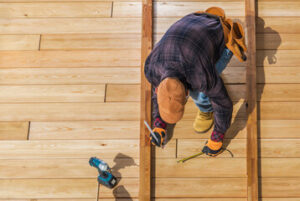A well-designed deck adds living space that you and your family can enjoy for years. It also increases the value of your home.

Before you begin construction, choose a builder and review his or her work history and reputation. It’s important to know how long the contractor has been in business and what kind of warranties they offer. Contact Deck Builder Stafford for professional help.
A deck is a substantial addition to any home, so proper site preparation is crucial. This stage sets the foundation for your project and ensures that it will be safe, durable, and aesthetically pleasing once complete. It includes a number of different tasks, including clearing the area and making sure the soil is level. Incorrect site prep can lead to structural problems later on, so this step is essential.
During this stage, you will mark out the footprint of your deck using stakes and string to make sure it will fit into your yard. You will also want to check for any existing structures like fences or gates that could be in the way. Finally, you will need to contact your local utility providers to have them flag any gas, water, or electrical lines in the area so they don’t get damaged during construction.
Once the foundation is in place, you can begin laying down the right bedding materials for your deck. This will include landscaping fabric, gravel base, and sand. The sand is important because it helps with drainage, preventing pooling around the foundation and ensuring that any water that does get underneath the deck will be efficiently removed.
After laying down the foundation, you can start installing the beams and joists that form the frame of your deck. It’s important to install these with precision, ensuring that they are parallel with the house and that you adhere to local building codes for spacing and height requirements.
Stairs are also an integral part of any deck, and this phase involves constructing them to ensure that they are both functional and aesthetically appealing. They must be properly spaced, and stairs should be constructed with a moderate and consistent slope to promote drainage and prevent the accumulation of snow or rainwater beneath the deck.
Once the joists and beams are in place, you can start to add your decking boards. Be sure to leave adequate space between boards for water drainage, and use screws or nails rather than nails to ensure that they are securely fastened. It’s also a good idea to allow the decking to acclimate outside before you begin installation.
Design
As with constructing a house, the deck design stage involves careful planning to establish the specific dimensions and layout of your new outdoor space. Consider factors such as available space, function, and architectural harmony with your home when deliberating on your deck’s size and shape. A well-thought-out deck design will ensure that the final product is a safe, durable, and functional addition to your home.
Prior to beginning the build, it is important to review local building codes and secure any necessary permits. Failure to follow these regulations can result in costly fines and the need to rebuild portions of your deck.
Once the site has been prepared, excavation and post hole drilling are required to establish a sturdy foundation for your new deck. Ensure that the concrete footings are properly attached and level, and that they adhere to the specified height of your deck in accordance with regional building standards.
Throughout the construction process, be sure to use a framing square and tape measure to maintain consistent measurements and an accurate overall structure. In addition, a circular saw and power drill are required tools to complete the construction phase.
Be sure to purchase sufficient amount of materials to account for miscalculations or adjustments that may occur during the installation. This will save time and money in the long run by avoiding additional trips to the hardware store. The decking boards are the visible face of your deck, and it is important to select a material that suits your personal preferences, budget, and maintenance needs. Common choices include pressure-treated wood, cedar, redwood, ipe, and composite materials.
Once the frame has been built and fastened, the decking boards can be installed. It is recommended that you leave a 1/8 in. margin around the perimeter to prevent warping or rot over time. It is also important to plan the layout of your deck boards so that they are free of unsightly gaps and butt joints. If you must trim a board, do so strategically by hiding it away from the entrance or in a low traffic area.
Materials
The material choice for a deck is one of the most crucial aspects of the construction process. It not only determines the deck’s aesthetic but also its structural integrity and longevity. It’s important to consider your needs and budget when selecting deck materials. Popular options include cedar, redwood, and pressure-treated lumber. These materials are affordable and durable but may not provide the visual impact you want for your deck. If you’re willing to spend a little more, you can select decking that’s constructed from exotic woods like ipe and tigerwood or high-end composite products.
Regardless of the material you choose, it’s essential to follow proper installation techniques for your deck. This ensures a long-lasting, safe deck that’s built to code. Before you start working, check with your local building department to make sure that you’ve secured all necessary permits. Failure to do so can result in fines and forced removal of any unapproved construction.
After securing the required permits, dig holes for your deck’s support posts. It’s generally recommended to place them 4 or 5 feet below ground level to prevent frost heave. You’ll need to add concrete to these holes to create a stable foundation for your deck.
Once the deck’s support structure is in place, you can begin laying its surface. If you choose to build a wood deck, it’s important to treat the boards with a preservative before assembling them together. This protects against the elements and keeps the boards from rotting or warping over time. It’s also a good idea to use a treated wood preservative in the post holes and footings to extend the life of your deck.
You should always use quality fasteners and deck screws for your deck. Stainless steel fasteners are preferred to avoid corrosion. If you’re using composite materials, choose zinc-coated fasteners or systems that conceal the fasteners. It’s also a good idea for wood structures to be covered or at least have adequate ventilation. Standing water can lead to rot or attract vermin, so covering your deck and keeping it properly ventilated is essential for its longevity.
Installation
When it comes to deck installation, there are some techniques that can make the process much easier and result in a more beautiful finished product. For example, it is important to keep in mind that gaps between boards can help with drainage and expansion and contraction. Proper gapping will also help ensure that fasteners do not show through the surface of the board. One way to achieve consistent gapping between deck boards is to use a spacer, such as a pencil or a scrap piece of wood. Another easy way to achieve consistent gapping is by using fasteners with a hidden head, such as Trex Hideaway Universal Hidden Fasteners. These fasteners are hidden behind the groove of the deck board, which helps minimize the appearance of screw heads.
Before beginning construction, it is essential to create a detailed plan of the deck. This should include dimensions and layout, as well as any special features like built-in benches or planters. It is also a good idea to consider utility options, such as lighting and other electrical fixtures. Finally, it is a good idea to consider the slope of the site and soil conditions, as these can affect how well a deck is built.
Once the deck plans are completed, it is important to verify that they comply with local building codes. Failure to do so can lead to expensive fines or even the need to tear down parts of the deck. For this reason, it is a good idea to work with a professional contractor. Professionals are experienced in working with building codes and can ensure that the deck is constructed according to specifications.
When hiring a professional to complete your deck installation project, it is important to obtain referrals from friends and family members. This will help you find a company with experience and a portfolio of past projects. In addition, a reputable company will offer a warranty on their work, which can provide peace of mind during the project. When selecting a deck contractor, be sure to choose one that offers convenient scheduling and transparent pricing.




